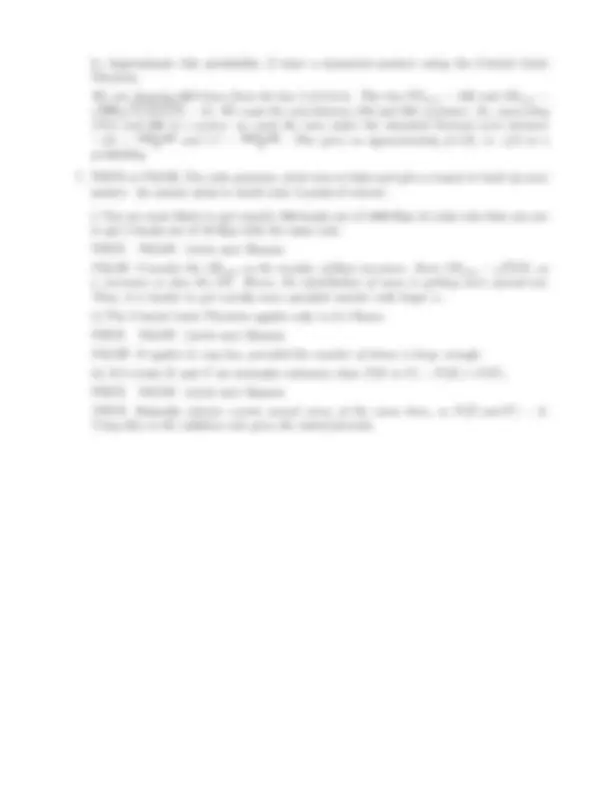



Study with the several resources on Docsity

Earn points by helping other students or get them with a premium plan


Prepare for your exams
Study with the several resources on Docsity

Earn points to download
Earn points by helping other students or get them with a premium plan
Community
Ask the community for help and clear up your study doubts
Discover the best universities in your country according to Docsity users
Free resources
Download our free guides on studying techniques, anxiety management strategies, and thesis advice from Docsity tutors
Material Type: Exam; Professor: Robertson; Class: Introduction to Statistics; Subject: Mathematics; University: Colgate University; Term: Unknown 1989;
Typology: Exams
1 / 3

This page cannot be seen from the preview
Don't miss anything!


SECTION ONE: Multiple Choice (5 points for each answer: 50 points total)
A. .500 B. .111 C. .667 D..
B The experiment is a Binomial process. Hence, the answer is
( 12 6
) (1/3)^6 (2/3)^6 ≈. 111.
A. 80; 8 B. 80; 16 C. 200; 8 D. 200; 16
B We expecet 400(1/5) = 80 with SEsum =
(1/5)(4/5) = 8. Hence, using the Central Limit Theorem, our approximate probability is the area to the left of 52.5 (using the. 5 correction for 0-1 boxes) on a Normal curve with mean 80 and standard deviation
(A) The number 5 is picked more than 35 times;
(B) The sum of the picks is less than 500.
Here are the questions:
i) The number of fives picked is , give or take , or so.
A. 24;.037 B. 24;3.65 C. 24; 4.38 D. 24; 8.
C The distribution is binary: 0,0,1,0,0. Hence, the expected number of ones is 120(1/5) = 24 with SEsum =
ii) The sum of the picks is , give or take , or so.
A. 720; 42.7 B. 600; 36.8 C. 720; 36.8 D. 600; 42.
A We use the distribution: 2 , 3 , 5 , 7 , 13 which has an average of 6 and a standard deviation of 3.9. Hence, our expected sum is 120(6) = 720 with SEsum =
i) The sum of the rolls should be , give or take , or so.
C The first blank is the EV and the second blank is the SE for the sum. We have EV =
100
1+2+3+ 4
= 250 and SE =
(1− 2 .5)^2 +(2− 2 .5)^2 +(3− 2 .5)^2 +(4− 2 .5)^2 4
ii) What is the approximate chance that the sum of rolls is less than 300?
D We use the information from part (a) to get the z-score of 300: z = 300 −^250
Consulting the Normal table for our approximation, we want the area to the left of 4.5. Clearly D is the closest answer.
iii) The number of threes rolled should be , give or take , or so.
D Here we have the binary distribution: 0 , 0 , 1 , 0. We find the EV and SE for sums. We have EV = 100(1/4) = 25 and SE =
iv) Estimate the chance that the number of threes rolled is between 15 and 20, exlusive.
C We use the information from part (c) to convert 15.5 and 19.5 to standard units: 15. becomes 154.^5. 33 −^25 = − 2. 19 and 19. 5 becomes 194.^5. 33 −^25 ≈ − 1. 27. Consulting the normal table for our approximation, we want the area between − 2. 19 and − 1. 27 which is approximately 8 .8%.
SECTION TWO: Short Answer ( 5 points for each answer: 30 points total)
(A) For both we use the Central Limit Theorem to approximate the probabilities. For (A), we want ≥ 36 , so we want the area to the right of 35.5 on a Normal curve with mean 24 and SD 4.38 (these numbers are from the solutions to question #4). Converting 35.5 we get a z-score of 35.^5 −^24
38 ≈ 2. 63. Doing the same for (B), we want the area to the left of 500 on a Normal curve with mean 720 and SD 42.7. We get a z-score of 500 − 720
7 ≈^ −^5.^2. Since (B)’s z-score is farther out in the tail, (A) must give a larger area and hence a higher probability of occuring.
A box contains 5 letters: A, B, C, D, E from which you are to draw 900 times, with replacement and at random.
a) Write an expression (I do not want a numerical answer) for the exact probability that you draw between 180 and 200 A’s.
This is a binomial process with n = 900 , k = 180 , 181 ,... , 200 , and p = 1 / 5 (the probability of picking an A). Hence, the expression is ( 900
180
180 (4/5) 720
181 (4/5) 719
200 (4/5) 700 .